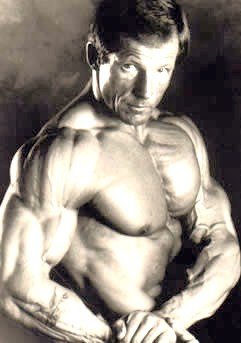You are here
Home ›He-Said-She-Said Volume 12

Q: Tracy, can you tell me what exercises I can do to build size and strength in my shoulders? My legs and back are fine, but my shoulders definitely need some work.
A: There is nothing like a good set of shoulders with well developed and defined muscle definition. Symmetry, which is highly regarded in natural bodybuilding, is defined as esthetic balance or harmonious arrangement. The shoulders (deltoids) definitely play a major role in our overall physical appearance.
 Even if you have narrow or boney shoulders you can create a fuller and more symmetrical look by weight resistance training. The shoulder joint is unique in that is relies on muscles and ligaments instead of the skeletal system for its stability. This allows for a large range of motion in the joint, but also makes it more susceptible to injury. Therefore, it is very important to develop all the muscles in the shoulder region to prevent injury.
Even if you have narrow or boney shoulders you can create a fuller and more symmetrical look by weight resistance training. The shoulder joint is unique in that is relies on muscles and ligaments instead of the skeletal system for its stability. This allows for a large range of motion in the joint, but also makes it more susceptible to injury. Therefore, it is very important to develop all the muscles in the shoulder region to prevent injury.
The deltoid is a muscle with 3 heads: anterior (front), lateral (side), and posterior (back). Here are three basic shoulder exercises that will help you to develop all three heads of the deltoid muscle:
- Overhead dumbbell (D/B) presses or barbell (B/B) presses works the anterior head
- Standing side lateral raises with a D/B works the lateral head
- Rear deltoid raises with a D/B works the posterior head
For optimum results and to prevent injury you should consider investing in a good weight training instruction book and a personal trainer to teach you the proper execution of these exercises.
Q:ᅠTracy, can you tell me some benefits of eating turkey, as I only eat it on special celebration meals. Should I include it in my regular diet?
A: Turkey is a leader in the 'lean' meat class, especially turkey breast. It's also compatible for all 4 Blood types. With the wide variety of fresh cuts available today it's easy to incorporate turkey into our daily menus.
Turkey is satisfying and very versatile. I steam bake turkey once a week and make a large pot of delicious and hearty soup with the bones. Turkey is an excellent source of high-quality protein. All the essential amino acids are present in abundance, explaining why turkey provides excellent food energy and the building blocks necessary for the renewal and maintenance of body tissues.
Turkey is both a good source of niacin, which the body needs to release energy from carbohydrates, and phosphorous, a mineral that contributes to the ongoing strength of bones and teeth. Turkey has fewer calories and contains less fat and cholesterol than many other meats.
Many people believe that the amino acid tryptophan in turkey causes sleepiness, but in fact it's the mashed potatoes and dressing that are to blame. Cut these out and turkey on its own will stimulate rather than sedate.
Often eaten to excess, the festive high-carb accompaniments are what typically drive blood sugar and insulin levels sky high, resulting in a rebound of low blood sugar and drowsiness. The overall net effect is also highly acidic and dehydrating.
Q:ᅠCory, have you heard about a new product called carnosine and its effect on health and muscle? How much should I take?
A: Carnosine is a dipeptide, a combination of the two amino acids alanine and histidine. It is naturally present in tissues like muscle and brain, but its concentration falls with advancing age. Vegetarians get none in their diet. It has some very interesting antioxidant properties. We know it protects cells from free radicals plus it helps reduce glycosylation. This is a damaging process where proteins and sugar molecules combine abnormally to form cross-linked, oxidized toxic compounds.
Carnosine is naturally present in functional muscle but declines as muscle weakens and atrophies due to non-use. It is possible that taking 500mg to 2000mg (10mg-20mg per kg of lean mass) of carnosine before and after workouts could help revitalize muscle and support the process of recovery and growth, especially in master athletes. Carnosine influences the production of nitric oxide and also plays a role as a neurotransmitter.

Volume 1
Volume 2
Volume 3
Volume 4
Volume 5
Volume 6
Volume 7
Volume 8
Volume 9
Volume 10
Volume 11
- Log in to post comments